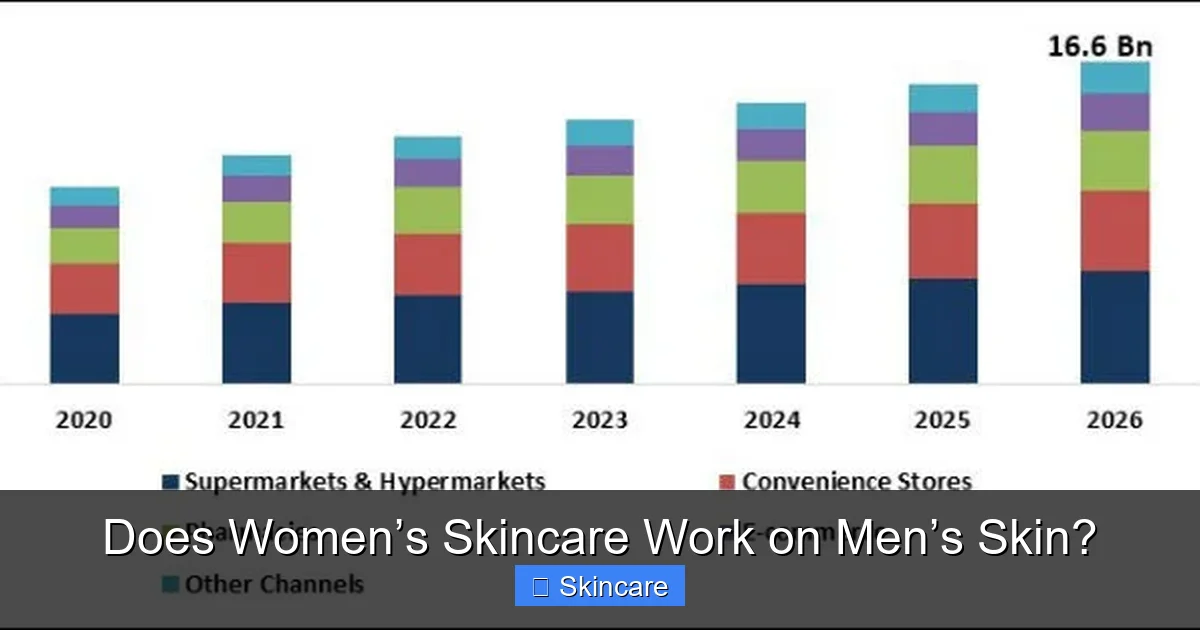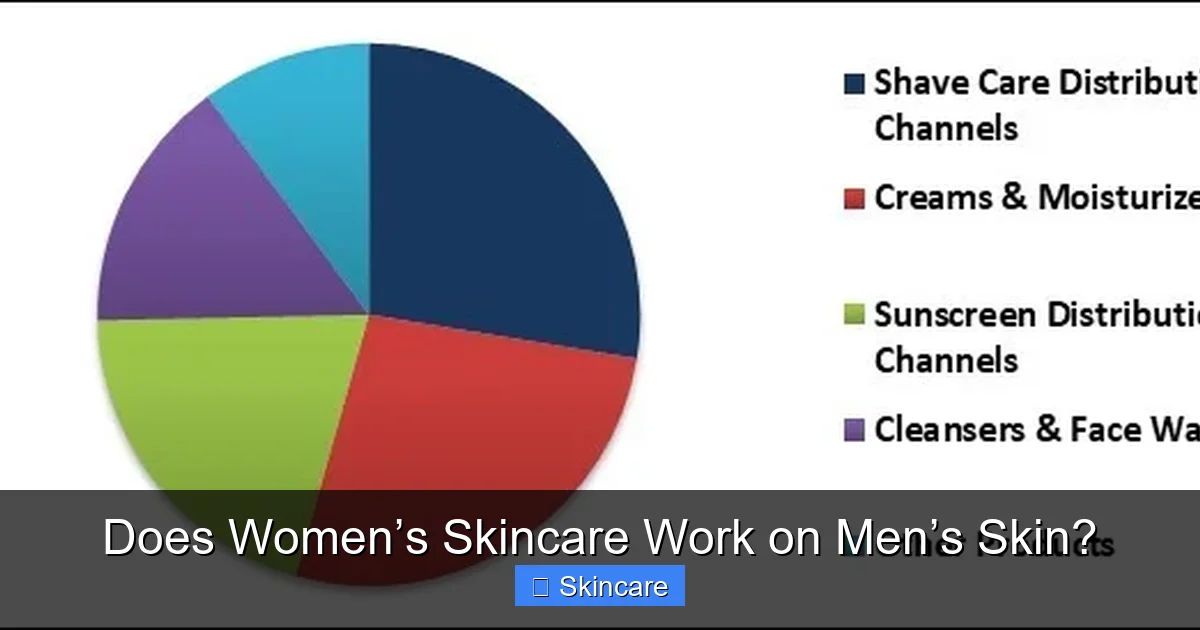
Featured image for this comprehensive guide about does women and men skincare products difference
Image source: kbvresearch.com
The beauty aisle can be a confusing place. Rows upon rows of creams, serums, and cleansers, often neatly divided into “for women” and “for men” sections. But have you ever stopped to wonder if this division is truly based on science, or if it’s mostly clever marketing? The question, “Does women’s skincare work on men’s skin?”, is far more common than you might think, and the answer is not as simple as a yes or no. In an era where inclusivity is key, understanding what truly drives effective skincare, beyond gendered packaging, is paramount.
For years, the narrative suggested men and women needed entirely different product formulations. Men’s lines often feature rugged packaging, “masculine” scents, and focus on practical, no-fuss solutions like post-shave balms. Women’s products, conversely, tend to emphasize anti-aging, hydration, and glow-inducing benefits with floral or subtle fragrances. But at its core, skin is skin. Both men and women experience concerns like dryness, oiliness, acne, and the inevitable signs of aging. So, let’s peel back the layers and uncover the truth about gender-specific skincare and whether your partner’s favorite serum could be your next holy grail.
📋 Table of Contents
- Understanding the Basics: Is Skin, Skin?
- Key Biological Differences Between Men’s and Women’s Skin
- Decoding Skincare Ingredients: Is There a Gender Bias?
- Marketing vs. Science: The “Pink Tax” and Packaging
- Crafting a Universal Skincare Routine: Focus on Skin Needs, Not Gender
- Conclusion: Embrace Ingredient-Focused Skincare
Understanding the Basics: Is Skin, Skin?
At a fundamental level, the anatomy of human skin is the same for everyone, regardless of gender. It consists of three main layers: the epidermis (outermost), dermis (middle), and hypodermis (innermost). All these layers contain the same cells – keratinocytes, melanocytes, fibroblasts – and perform the same vital functions: protection, regulation, and sensation. So, in the most basic sense, yes, skin is skin.
However, this doesn’t mean there are no differences. Hormones, primarily testosterone and estrogen, play a significant role in influencing various aspects of skin physiology, leading to noticeable distinctions between typical male and female skin. These differences are what skincare brands often leverage, but it’s crucial to understand their extent and impact before dismissing women’s skincare products for men, or vice-versa.
| Aspect | Women’s Skincare & Skin | Men’s Skincare & Skin |
|---|---|---|
| Skin Characteristics | Thinner, lower collagen density, more prone to dryness, hormonal fluctuations, typically higher pH. | Thicker, higher collagen density, oilier, larger pores, more facial hair, typically lower pH. |
| Common Skin Concerns | Anti-aging, hydration, hyperpigmentation, texture refinement, sensitivity, fine lines. | Razor burn/irritation, oil control, ingrown hairs, sun protection, firming (often in simpler routines). |
| Product Formulation | Wider range of textures (creams, serums, oils), complex active ingredients (e.g., multiple peptides, advanced retinoids, brightening agents). | Often lighter textures (gels, lotions), focus on soothing, calming, oil-absorbing ingredients (e.g., salicylic acid, witch hazel, aloe). |
| Fragrance & Packaging | Diverse scents (floral, fruity, “clean”), often intricate, aesthetically driven packaging, wider color palettes. | Masculine scents (woody, musky, “fresh”), minimalist, functional packaging, often darker or neutral tones. |
| Marketing Focus | Emphasizes beauty, anti-aging, specific skin benefits, self-care, comprehensive routines. | Focuses on efficiency, performance, grooming, simplicity, often addressing shaving needs and athletic lifestyles. |
Key Biological Differences Between Men’s and Women’s Skin
While the basic structure is shared, several biological factors contribute to why men’s and women’s skin often behave differently. These distinctions are not absolute for every individual but represent general trends:

Learn more about does women and men skincare products difference – Does Women’s Skincare Work on Men’s Skin?
Image source: kbvresearch.com
Skin Thickness and Texture
- Men’s Skin: Generally about 20-25% thicker than women’s due to higher collagen density. This often makes men’s skin appear firmer and more rigid. It also tends to age differently, often showing deeper wrinkles later in life rather than fine lines earlier.
- Women’s Skin: Tends to be finer and can sometimes appear more delicate.
Sebum (Oil) Production
- Men’s Skin: Testosterone stimulates sebum glands, leading to men typically producing more oil. This results in larger pores and a greater propensity for oiliness and acne, especially during adolescence. Research indicates men’s sebum production can be twice that of women’s.
- Women’s Skin: Sebum production fluctuates with hormonal cycles and tends to be lower overall compared to men, leading to less pronounced oiliness for many.
Collagen Density and Aging
As mentioned, men generally have higher collagen density, which explains why their skin often appears firmer and ages at a seemingly slower pace, with wrinkles appearing later. However, when wrinkles do appear, they tend to be deeper due. Women, with typically lower collagen levels, may experience earlier onset of fine lines and wrinkles, particularly around the eyes and mouth.
Hydration Levels
While not a strict rule, men’s skin tends to have lower Natural Moisturizing Factors (NMFs) and can be prone to dehydration, despite higher oil production. This means even oily male skin can benefit immensely from good hydration.
Shaving and Its Impact
A unique challenge for men is daily shaving. This process not only removes hair but also strips away the outermost layer of skin cells, leading to increased sensitivity, dryness, irritation, razor burn, and ingrown hairs. This consistent exfoliation and potential trauma can compromise the skin’s barrier function, making it more vulnerable to environmental aggressors.
Decoding Skincare Ingredients: Is There a Gender Bias?
This is where the marketing often deviates from the science. Active ingredients—the workhorses of any skincare product—don’t care about your gender. Ingredients like hyaluronic acid, retinol, Vitamin C, salicylic acid, niacinamide, and SPF deliver their benefits irrespective of whether they’re packaged in a sleek black bottle or a pastel-colored jar.

Learn more about does women and men skincare products difference – Does Women’s Skincare Work on Men’s Skin?
Image source: kbvresearch.com
- Hydrators (e.g., Hyaluronic Acid, Glycerin): Essential for both men and women to maintain skin plumpness and prevent dehydration.
- Antioxidants (e.g., Vitamin C, Vitamin E): Combat free radical damage from environmental stressors, crucial for healthy skin regardless of gender.
- Exfoliants (e.g., AHAs, BHAs): Help to clear pores, improve skin texture, and promote cell turnover, beneficial for managing acne and improving radiance for all.
- Anti-aging Ingredients (e.g., Retinol, Peptides): Stimulate collagen production and reduce the appearance of fine lines and wrinkles in both male and female skin.
- Sun Protection (SPF): Non-negotiable for everyone. UV radiation is the leading cause of premature aging and skin cancer, affecting all individuals equally.
The efficacy of an ingredient depends on its concentration, the product’s formulation, and how it interacts with an individual’s specific skin concerns, not their gender.
Marketing vs. Science: The “Pink Tax” and Packaging
The primary difference you often see between men’s skincare products and women’s skincare products lies in packaging, fragrance, and marketing. Men’s lines typically feature:
- Rugged Aesthetics: Darker colors, minimalist designs, angular bottles.
- “Masculine” Scents: Often woodsy, musky, or fresh, steering clear of floral or sweet notes.
- Simplified Routines: Focus on 2-in-1 or 3-in-1 products, catering to a perceived desire for efficiency.
Conversely, women’s lines often come in softer colors, more elaborate packaging, and a wider range of fragrances. This segmentation creates a perception of distinct needs, sometimes leading to the “pink tax” phenomenon where similar products marketed to women are priced higher, or, in the case of men’s products, premium pricing for what are often basic formulations.
The truth is, these distinctions are largely superficial. A moisturizer is a moisturizer. A serum is a serum. What truly matters are the ingredients inside and how they address your unique skin type and concerns. Don’t let clever advertising dictate your choices; empower yourself with knowledge about ingredients.
Crafting a Universal Skincare Routine: Focus on Skin Needs, Not Gender
Instead of asking, “Does women’s skincare work on men’s skin?”, a better question is, “What does my skin need?” The core principles of an effective skincare routine remain consistent for everyone:
- Cleanse: Use a gentle cleanser twice daily to remove dirt, oil, and impurities without stripping the skin.
- Treat: Address specific concerns with targeted serums. For oily skin, consider salicylic acid; for aging, retinol; for hyperpigmentation, Vitamin C.
- Moisturize: Hydrate your skin to support its barrier function. Even oily skin needs moisture. Choose lighter gel-based formulas for oily skin and richer creams for dry skin.
- Protect: Apply a broad-spectrum SPF 30 or higher every morning, rain or shine.
Addressing Specific Male Concerns:
While the core routine is universal, men can incorporate specific steps to address issues related to shaving:
- Pre-Shave Prep: Use a warm compress or pre-shave oil to soften hair and skin, reducing friction.
- Gentle Shaving Cream: Opt for a hydrating, non-foaming cream to minimize irritation.
- Post-Shave Balm: An alcohol-free balm with soothing ingredients like aloe vera or allantoin can calm irritation and restore moisture.
Comparing General Skin Characteristics & Product Needs:
To further illustrate that needs often overlap, consider this simplified comparison:
| Characteristic | Typical Male Skin | Typical Female Skin | Common Skincare Needs |
|---|---|---|---|
| Thickness | Thicker, firmer | Thinner, more delicate | Barrier support, hydration |
| Oil Production | Higher (prone to oiliness, acne) | Variable (can be dry, oily, combo) | Oil control, pore clearing, hydration balance |
| Aging Signs | Deeper wrinkles, later onset | Finer lines, earlier onset | Collagen support, antioxidant protection |
| Sensitivity | Often due to shaving | Can be hormonally driven | Soothing, anti-inflammatory ingredients |
| Pigmentation | Sun spots, uneven tone | Melasma, sun spots, uneven tone | UV protection, brightening agents |
As the table shows, while the *causes* or *presentations* of skin issues might differ slightly, the *solutions* (ingredients) are largely universal.
Conclusion: Embrace Ingredient-Focused Skincare
In conclusion, the answer to “Does women’s skincare work on men’s skin?” is a resounding yes! Skincare should be gender-neutral. Biological differences exist, but they dictate skin *type* and *concerns*, not the gender of the person. Your focus should always be on understanding your own skin’s unique needs – whether it’s battling dryness, managing oiliness, reducing sensitivity, or targeting signs of aging. Read ingredient labels, research formulations, and don’t be swayed by marketing ploys.
By shifting your perspective from gender-specific products to ingredient-focused solutions, you open up a world of effective skincare possibilities. Whether you’re a man borrowing your partner’s hyaluronic acid serum or a woman reaching for a “men’s” no-nonsense SPF, remember that good skincare is smart skincare, and smart skincare is for everyone. Invest in ingredients that work for *your* skin, and you’ll reap the benefits, regardless of the label.
🎥 Related Video: Men vs Women's Skin – Do Men Need Different Skincare Products? – Ask Dr. Steve
📺 Geologie
There are a few biological differences between men and women’s skin. Men have skin that tends to be 25% thicker and produces …
Frequently Asked Questions
Is there a real difference between men’s and women’s skincare products?
While men’s and women’s skin have physiological differences, many core skincare principles and active ingredients are universal. The primary distinctions often lie in product texture, fragrance, packaging, and marketing, rather than entirely different functional ingredients.
Can men use women’s skincare products effectively?
Absolutely, men can use women’s skincare products effectively, and vice versa. The efficacy of a product depends far more on matching its ingredients to an individual’s skin type and concerns (e.g., oily, dry, sensitive, aging) than on the gender it’s marketed towards.
What are the key physiological differences between men’s and women’s skin?
Men’s skin tends to be thicker, oilier due to more active sebaceous glands, and generally has a higher collagen density, which can delay the appearance of fine lines. Women’s skin is typically thinner, experiences greater hormonal fluctuations, and may be more prone to dryness or sensitivity.
Do women’s skincare products contain ingredients unsuitable for men’s skin?
Generally, no. Most active ingredients like hyaluronic acid, vitamin C, retinol, or ceramides are beneficial for all skin types and genders. Any potential irritation or adverse reaction would be due to an individual allergy or sensitivity to a specific ingredient, not because the product is exclusively “for women.”
Is the distinction between men’s and women’s skincare mostly marketing?
To a significant extent, yes. While subtle physiological differences exist, much of the separation into “men’s” and “women’s” skincare lines is driven by marketing strategies, scent preferences, and packaging design. Functionally, many products with similar active ingredients will deliver comparable results regardless of their gendered label.
When choosing skincare, should men prioritize specific “men’s” lines or ingredients?
Men should prioritize products based on their specific skin needs and concerns, rather than solely on whether it’s labeled “for men.” Focus on ingredients that target issues like acne, dryness, sensitivity, or signs of aging, regardless of the product’s gender-specific marketing. The most effective routine is one tailored to your individual skin, not your sex.
